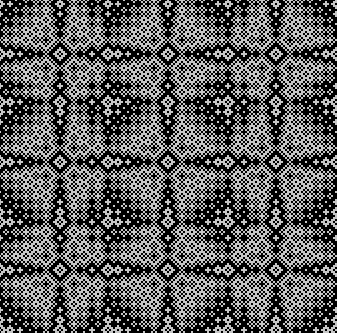

Maple Hill Software was founded by Ravi Nielsen, owner and programmer, and myself Jyoti Coyle, artist and weaver, in 1984. Later that year, we released our first weaving program, Patternland Weave Simulator (PWS) for IBM compatibles. During 1969 and 1970, I studied weaving with Else Regensteiner at the Art Institute of Chicago learning the drafting process for weaving and intensifying my love for pattern and texture. Inspired by beautiful bitmap pattern appearing in art cinema and the more fluid pattern of marbleization, I developed a passion for painting fractal-like non-repeating pattern. I dreamed of being able to program a computer to remove the tedious work of filling in squares on graph paper to create more elaborate pattern in weaving. I also envisioned software that could produce printouts scaled to the sett of the weave and read-able drafts on graph paper containing the numbers and symbols of harnesses or treadles as well as the woven design, similar to Else Regensteiner’s drafting style.
Pursuing that dream I earned a master of arts degree in fine art/weaving and computer aided design (C.A.D.) at Goddard College in 1985. I studied the Pascal computer language, completing simple preliminary programming, and wrote about the process of using C.A.D. in the creation of woven artform. My thesis titled Alice in Patternland also explored the spiritual metaphor of pattern and weaving. During my study Ravi Nielsen, my husband, took over all of our programming. (Besides being the programmer of Maple Hill Software, he is also Director of Information Services at Goddard College.) Both of my dreams for computerized drafting for woven design have been realized and maintained in our software to this day. In 1987 we released our second DOS program Patternland Pattern Grapher, software for tapestry design and the fiberarts, including needlepoint, embroidery, cross-stitch and bead-weaving. Pattern Grapher was used by Sigrid Piroch to document Slovak on-loom embroidery patterns.
In 1989 Maple Hill Software and Citadel Enterprises invented the Loom Interface Port Standard (LIPS). Citadel Enterprises is owned by Bob Kelly, an electromechanical engineer, and Jacquie Kelly, an accomplished recognized weaver. Together we placed LIPS in the public domain to encourage a standard and make loom support convenient for loom and software companies alike. Schacht’s Combby and Cyrefco’s Compumarche computerized looms employ the LIPS interface. We created our own mechanical prototype for my Norwood 50” 8-harness loom using a LIPS circuit board, which can be purchased from Citadel. Jim Barr of Wonderful Woolenworks in British Columbia used Patternland with LIPS to drive his 32-shaft air-powered dobby loom. Loom control enables the computer to tell a loom, fitted with an electromechanical interface, which harnesses to raise or lower, by simply pointing with the mouse, or cursor, to the desired row and pushing a pedal on the loom. Patternland’s loom control allows the user to weave sequentially or selectively any weft row desired enabling free-form designing while at the loom. Our programs include loom control as an embedded feature which we turn on or off at time of shipment, allowing the user to upgrade to this capability when it is needed. We were also the first software company to support the J-Made J-Comp computerized 24-shaft loom. In 1990 we released our third DOS program Patternland Light Weave, an entry level Weave Simulator with loom control for quick design-and-weave capability.
Patternland programs are extremely versatile, allowing the weaver to choose any editing format as a draw-down or draw-up with a left or right positioned tie-up. The weaver can create large color palettes and choose from graphics (small squares or pixels), characters, symbols or numbers when designing and printing with optional scaleable graph paper and highlight lines. Our software functions interactively, creating an interlacement that forms as you draft, not requiring separate steps to see what you have done. Patternland Weave Simulator was used by Jane Evans to do research for and illustrate her book, A Joy Forever: Latvian Weaving. Utilizing our numeric format, Interweave Press employed PWS to record and check hundreds of pattern drafts for accuracy during the creation of A Weaver's Book of 8-Shaft Patterns, edited by Carol Strickler. In 1991, we released our fourth DOS program Patternland Weave Publisher developed specifically for publication of that book, to create drafts in the style of Handwoven Magazine.
Released August 1, 1996, Patternland Weave Simulator for Windows 6.0 (PWSW) combines the best of our DOS programs in an entirely new program with a beautiful graphical user interface utilizing full Windows capabilities. We now support the AVL Compu-Dobby, the Louet Magic Dobby Electronic Interface, and the Macomber Air Dobby and Electronic Single Pedal computerized looms. Warp threads, weft picks, shafts, treadles and lift-plan rows are virtually unlimited. Our newest project has been the creation and support of a supplemental data file format called a Weaving Information File (WIF). Ravi, Rob Sinkler of Swiftweave for the MacIntosh, and Bob Keates of Fiberworks PCW worked collaboratively to define this new data format. WIF will allow weavers to easily transport weaving files between software programs and computer types, and encourage publication of pattern libraries on disk.
1/97
Home Page
Copyright © 1997 Maple
Hill Software
Last updated: 1/8/97